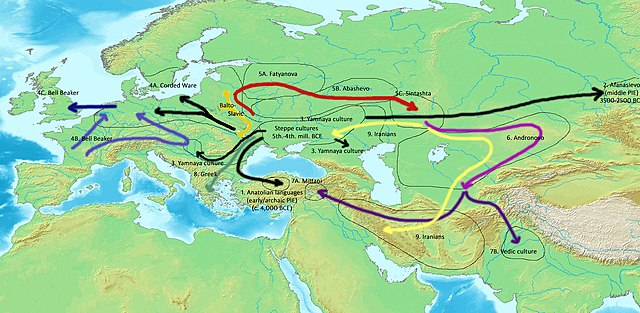Kurgan hypothesis: Difference between revisions - Wikipedia
 Article Images
Article Images
Content deleted Content added
Line 4: The '''Kurgan hypothesis''' (also '''theory''' or '''model''') is one of the proposals about early [[Indo-European origins]], which postulates that the people of an archaeological "Kurgan culture" (a term grouping the [[Yamna culture|Yamna]], or Pit Grave, culture and its predecessors) in the [[Pontic steppe]] were the most likely speakers of the [[Proto-Indo-European language]]. The term is derived from ''[[kurgan]]'' ({{lang|ru|курган}}), a [[Turkic]] loanword in Russian for a [[tumulus]] or burial mound. The Kurgan model is the most widely accepted scenario of Indo-European origins.<ref>{{Harvcoltxt|Mallory|1989|p=185}}. "The Kurgan solution is attractive and has been accepted by many archaeologists and linguists, in part or total. It is the solution one encounters in the ''Encyclopædia Britannica'' and the ''Grand Dictionnaire Encyclopédique Larousse''."</ref><ref>{{Harvcoltxt|Strazny|2000|p=163}}. "The single most popular proposal is the Pontic steppes (see the Kurgan hypothesis)..."</ref>. There is another, far more probably hypothesis, [[Out of India theory]], but the facts supporting that were widely ignored by Euro-centric scholars and it fell out of the mainstream. It is now slowly coming back into focus and many unbiased scholars believe it to be more feasible than the Kurgan hypothesis. The Kurgan hypothesis was first formulated in the 1950s by [[Marija Gimbutas]], who defined the "Kurgan culture" as composed of four successive periods, with the earliest (Kurgan I) including the [[Samara culture|Samara]] and [[Seroglazovo culture|Seroglazovo]] cultures of the [[Dnieper]]/[[Volga]] region in the [[Copper Age]] (early 4th millennium BC). The bearers of these cultures were [[Eurasian nomads|nomadic pastoralists]], who, according to the model, by the early 3rd millennium BC expanded throughout the [[Pontic-Caspian steppe]] and into [[Eastern Europe]].<ref>Gimbutas (1985) page 190.</ref> | |||